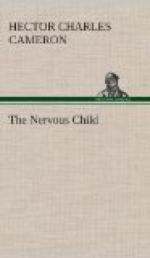Light and broken sleep is a common accompaniment of a too excitable and overstimulated brain. The placid child, who eats well, plays quietly, and does not cry more than is usual, as a rule sleeps so soundly that no ordinary sounds, such as conversation carried on in quiet tones in his neighbourhood, have the power to waken him. When he wakes, he does so gradually, perhaps yawning and stretching himself. The nervous child may move at the slightest sound, or with a sudden start or cry is wide awake at once. A hard mattress should be chosen without a bolster, and with only a low pillow. Flannel pyjamas, which cannot be thrown off in the restless movements of the child, should be worn. The temperature of the room should be cool, and the air from the open window should circulate freely, while draughts may be kept from striking on the child by a screen. All the sensations of the nervous child are abnormally acute. Thus, for example, an itching eruption, or tight clothing, will produce an altogether disproportionate reaction, and may result in a frenzy of opposition. Especially such a child is sensitive to a stuffy atmosphere or to an excess of bedclothes. Cool rooms and warm but light and porous clothing are essential. An electric torch, which can be flashed on the child for an instant, will assist the mother or nurse to make sure that the child has not thrown off all the bedclothing.
Sometimes want of sleep is accounted for by a real want of physical exercise. Town children especially are apt to suffer from their limited opportunities of running freely in the open. It is often considered enough that the child seated in his perambulator should take the air for three or four hours daily, while much of his time indoors as well is devoted to sitting. It is necessary for his proper development that he should have opportunities of daily exercise in the open. If for any reason this is not always practicable, a large room, as free as possible from furniture, should be chosen, with windows thrown wide open, in which the child may romp until he is tired.
It is rare for children of two or of three years of age, whose case we are now considering, to be troubled by bad dreams, nightmares, or night-terrors. If these should occur, obstructed breathing due to adenoid vegetations is sometimes at work as a contributory cause.
Finally, we should always remember that refusal of sleep is, for the most part, caused and kept up by harmful suggestions derived from mother and nurse, who allow the child to perceive their distress and agitation, who speak before the child of his habitual wakefulness, who unwittingly focus his attention on the difficulty. It is cured in the moment that the suggestion in the child’s mind is reversed, in the moment when he comes to regard it as characteristic of himself not to make a fuss about going to bed, but to sleep with extraordinary readiness and soundness. Let every one join together to produce this effect. Let the suggestion act strongly on his mind that all these troubles of sleeplessness are diminishing, that night after night sees an improvement, and soon his reputation as a good sleeper will be established, and, as always with children, it will be rigidly adhered to.




